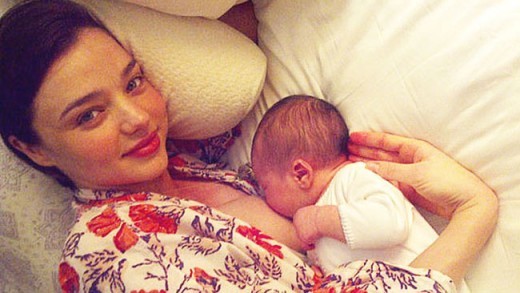Breastfeeding in Public: An Analogy Between the Female Breasts and Tomatoes


Miranda Kerr created quite a stir when she published on her own website a photo of her breastfeeding her newborn son Flynn. The negative reaction from the critics of breastfeeding in public is quite baffling considering that the Victoria's Secret model had previously posed nude and not a howl of protest at the sight of her exposed breasts was raised. Fast forward and motherhood beckoned, the same breast is exposed but with a baby attached to it and the photo is now considered distasteful. Is it the breast, the baby or the baby attached to the breast that makes the photo unappealing? Or is it because breastfeeding is considered to be a mundane activity that should be kept hidden in private? Both photos look great depending on the viewer’s perspective. Miranda in the nude speaks of the beauty of the human body while Miranda breastfeeding evokes a wave of emotion associated with motherhood bliss and the unspeakable bond between mother and child.
The pro-breastfeeding in public argument
Breastfeeding is best for babies. Not only does it provide the nutrients essential for the baby’s growth and development, it also strengthens the bond between mother and child with lots of skin-to-skin contact during breastfeeding. Babies are designed to have their needs satisfied immediately irrespective of the time, place and situation. Breastfeeding in public is being done by mothers out of necessity of placating a hungry baby and without any intention of offending the sensibilities of the people around her. Far from being exhibitionists, mothers are simply carrying out the primary function of the breasts as nature intended them to be.
The anti-breastfeeding in public argument
Critics of breastfeeding in public find the act unacceptable because of their perception that it constitutes indecent exposure. Their main argument is that they should be able to enjoy public places without the ‘vulgarity’ associated with an exposed breast while feeding the baby.
Dissecting the argument against breastfeeding in public
We live in a society where certain values are sometimes taken in absolute without regard to the motive behind a person’s action. Decent behaviour is taken to mean absolutely no exposure of any private part in public. It doesn’t matter if breastfeeding is meant to sustain a small human being who is too young to control the urge to have a basic need fulfilled. There is no malicious intent in breastfeeding in public but it is rather a simple gesture of nurturing that a mother is expected to do for her young. The malice is concocted in the minds of those people who find breastfeeding in public unacceptable. We proclaim that we care and protect the young and the vulnerable in our society and yet some quarters find it repulsive to see a mother giving the best food possible to her baby in public.
The need for a paradigm shift
The anatomy of the female breast gives away its primary function ie to produce milk to nurture the young. Breastfeeding should come naturally as it was in the days of old and should not be burdened by society’s myopic expectation of what a decent behaviour should be. With the evolution of the role of women in society and the development of infant formula, breast milk is no longer the single option to feed the baby. Breastfeeding evolved from being a compulsory activity to a freedom of choice.
In Australia, 90% of mothers initiate breastfeeding but sadly only 1% continues to breastfeed up to six months which is the minimum period recommended by the World Health Organisation for breastfeeding. No wonder critics of breastfeeding in public find the act to be an exception rather than the rule. With such a small minority of women breastfeeding for a considerable time, breastfeeding in public continues to be a rarity.
Making breastfeeding generally accepted in society is a complicated task. It is not as easy as convincing the people who do not support breastfeeding in public. It will certainly help in erasing the social stigma but the issue is not only about changing the psyche of non-believers of breastfeeding in public. Convincing mothers to breastfeed longer is a good place to start. Getting mothers to go back to the basics of breastfeeding will increase the probability of them breastfeeding in public until it gets to the point that this activity becomes a common sight in public. This in itself is no easy task considering how women’s role has evolved over the years and breastfeeding can pose an inconvenience to a mother’s occupation.
Both mothers breastfeeding in public and the people who are opposed to such activity have an equal right to use public places. In developed countries, anti-discrimination laws protect the mothers’ right to breastfeed in public. As we live in a democratic society we also need to respect the mindset of others no matter how convoluted they may come across. Out of respect for those people who feel uncomfortable looking at such situations in public, this means being more discreet in breastfeeding the baby outside of the confines of their homes. In saying this, mothers are under no obligation to offer excuses for breastfeeding in public.
Public decorum is not strictly based on law and order but in some cases they are products of prolonged exposure and long-term conditioning to certain behaviours. This brings to mind the similarity between the female breasts and tomatoes. Majority of people look at tomatoes as a vegetable. From a scientific point of view, a tomato is actually a fruit. In the same manner, people have been conditioned to look at the female breasts as a sex object. Undoing this association is like rebooting a section of one’s long-term memory. People need to look through rose-colored glasses whenever they see a mother breastfeeding in public. In such instances, the female breast is revealed not in a sexual manner but rather as a component of human anatomy meant to nourish the young.








